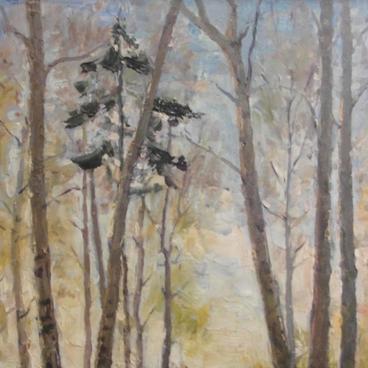In the foreground of Nikolai Baskakov’s painting, we see a concentrated white-haired man. He is wearing a white shirt and a black necktie. The man’s right arm is lying on the table, and the other, bent at the elbow, is touching the forehead in a distrait gesture. The scientist is reading some working materials or contemplating new ideas. This is the impression the spectator gets looking at the academician’s serious face.
The formal clothes show that the academician has recently returned to his study from some important scientific event. It seems that his jacket which he has just taken off is hanging on the back of his chair invisible to the spectator, or somewhere on a hanger. The scientist’s study serves as the background. It is evidenced by the bookcase piled with books appearing further away.
Restrained colors prevail in the canvas color palette. Nikolai Baskakov managed to convey the working mood emanating from the man sitting at the table. Unfortunately, the study furnishings do not allow to determine the branch in which the scientist received his academic the title of an academician. It is only obvious that it is not only a portrait of an outstanding man before us, but also a piece created by a remarkable artist.
Nikolai N. Baskakov who painted the academician’s portrait was born in a small village near Astrakhan on May 8, 2918. In 1939, he finished the Astrakhan Art School where he studied in the class of famous painter and pedagogue Pavel A. Vlasov. Right after his studies, he was called into the army, served in the Far East, where, in 1943, his works were first presented at an exhibition.
In 1945, Nikolai Baskakov continued his professional education by entering the Repin Leningrad Institute of Art. He was lucky to study from such talented artists as Boris Fogel, Leonid Ovsyannikov, and Gleb Pavlovsky. In 1951, Nikolai Baskakov was admitted to the Leningrad Union of Artists.
Preferring oil painting technique, the artist created many canvases dedicated to military, industrial, history and revolution subjects. His artistic heritage also includes landscapes, portraits, and etudes painted from nature. Baskakov, who was a member of the Peter Academy of Sciences and Arts, often addressed socially significant subjects in his art revealing on his canvases images of his contemporaries.
Nikolai N. Baskakov deceased in Saint Petersburg on October 14, 1993, in the 76th year of his life.
The formal clothes show that the academician has recently returned to his study from some important scientific event. It seems that his jacket which he has just taken off is hanging on the back of his chair invisible to the spectator, or somewhere on a hanger. The scientist’s study serves as the background. It is evidenced by the bookcase piled with books appearing further away.
Restrained colors prevail in the canvas color palette. Nikolai Baskakov managed to convey the working mood emanating from the man sitting at the table. Unfortunately, the study furnishings do not allow to determine the branch in which the scientist received his academic the title of an academician. It is only obvious that it is not only a portrait of an outstanding man before us, but also a piece created by a remarkable artist.
Nikolai N. Baskakov who painted the academician’s portrait was born in a small village near Astrakhan on May 8, 2918. In 1939, he finished the Astrakhan Art School where he studied in the class of famous painter and pedagogue Pavel A. Vlasov. Right after his studies, he was called into the army, served in the Far East, where, in 1943, his works were first presented at an exhibition.
In 1945, Nikolai Baskakov continued his professional education by entering the Repin Leningrad Institute of Art. He was lucky to study from such talented artists as Boris Fogel, Leonid Ovsyannikov, and Gleb Pavlovsky. In 1951, Nikolai Baskakov was admitted to the Leningrad Union of Artists.
Preferring oil painting technique, the artist created many canvases dedicated to military, industrial, history and revolution subjects. His artistic heritage also includes landscapes, portraits, and etudes painted from nature. Baskakov, who was a member of the Peter Academy of Sciences and Arts, often addressed socially significant subjects in his art revealing on his canvases images of his contemporaries.
Nikolai N. Baskakov deceased in Saint Petersburg on October 14, 1993, in the 76th year of his life.



